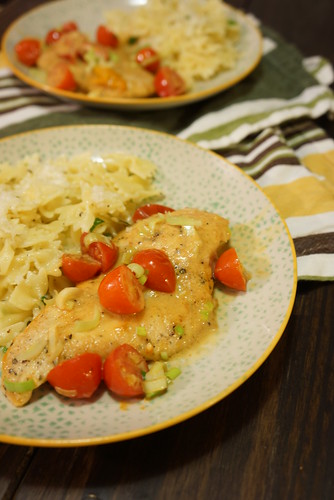On our trek back home from Seattle I read Culinary Intelligence (so... it's been a while). It's a little bit about the history of why we eat the way we do and then ways to get around the human complex of eating as much as possible.
The little history part included the fact that cooking is really what separated humans from our other ape ancestors. Cooking meat (and vegetables) started the digestion process for us so we could quickly convert food to energy, which made our digestive tract smaller (no need for that long digestive process any more) and our brains larger. As many diets are currently shifting to less meat and more raw ingredients, Kaminsky wonders is we might be heading in the wrong direction.
Of course, much has changed since the days of living in caves. We don't need as much protein when we're sitting at desks all day instead of hunting and gathering (besides, there are plenty non-meat protein sources). I do think he has a point on raw food though. Although my resolution last year was to eat at least one serving of vegetables raw, it is important to get a mix of both raw and cooked foods. Many foods offer different nutrients when they are in raw form verses cooked. For example, cooking spinach breaks down some of the vitamins, on the other hand cooking tomatoes adds lycopene, an antioxidant known to lower cancer risk.
Another point made in Culinary Intelligence is that when thinking about your last meal, or maybe optimal meal, most people would choose a meat entree. A steak, hamburger, filet minon, etc. Why is that? Meat has traditionally been viewed as a rare treat, the ultimate indulgence. Fish is the protein you eat when other meat is not available or while practicing penance (and the reason for Friday fish fry). And produce, well, people generally don't associate produce as a main course.
There are four elements of taste; salt, sweet, spicy heat, and tart/tangy/acidic... and one bonus element "umami" (Japanese for "tasty"). Keeping these elements in mind, if an ingredient doesn't increase the flavor in one of these elements, then it is probably not worth adding.
One of Kaminsky's cooking secrets was sealing meat and its marinade in a plastic pouch and then boiling said pouch for the ultimate cooked meat that has all of the flavor and is still fall of the bone tender. This technique is called "sous-vide" (under pressure).
Last but not least, the idea repeated throughout the book was achieving maximum flavor per calorie. The more you enjoy a meal, the more satisfied you are while still eating less overall. While I definitely agree that eating something delicious prevents me from snacking later on... some high calorie foods (like cookies or cheesecake) I will always want more of even after I feel full and satisfied!
Overall, the book had some interesting points. It took me longer than normal to read it because it was a little repetitive. If you want to learn more about life as a food columnist or more details about the four elements of taste, check out this book! Otherwise, just remember when you're reaching for that low-fat or low-calorie item, if it is going to leave you unsatisfied and looking for a snack in ten minutes, maybe you should be opting for a small portion of the full fat version instead.
![IMG_1712[1]](http://farm6.staticflickr.com/5504/12199456216_deebf26534.jpg)
![IMG_1713[1]](http://farm6.staticflickr.com/5532/12199453456_332c865a5f.jpg)









